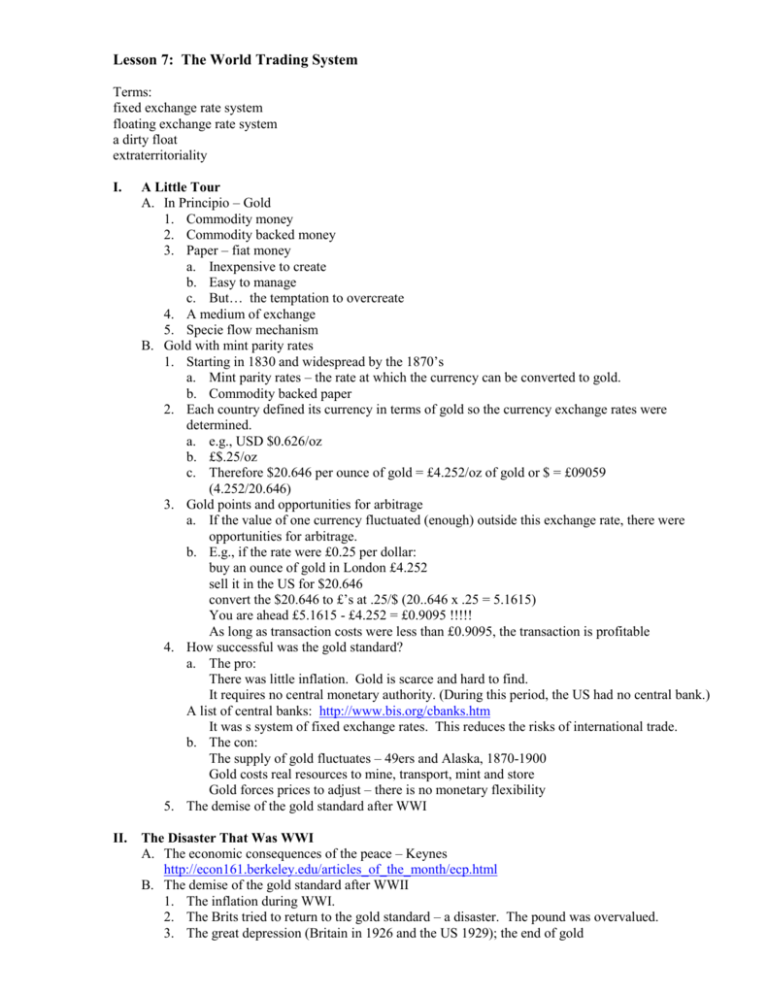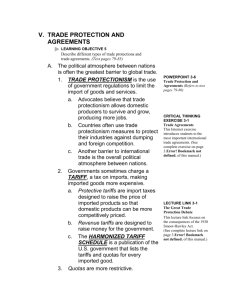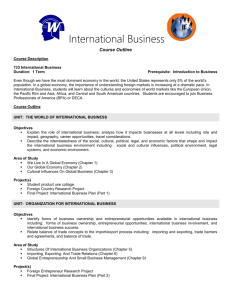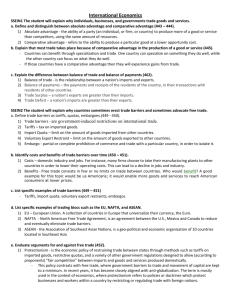Chapter 7 - McNeil Econ
advertisement

Lesson 7: The World Trading System Terms: fixed exchange rate system floating exchange rate system a dirty float extraterritoriality I. A Little Tour A. In Principio – Gold 1. Commodity money 2. Commodity backed money 3. Paper – fiat money a. Inexpensive to create b. Easy to manage c. But… the temptation to overcreate 4. A medium of exchange 5. Specie flow mechanism B. Gold with mint parity rates 1. Starting in 1830 and widespread by the 1870’s a. Mint parity rates – the rate at which the currency can be converted to gold. b. Commodity backed paper 2. Each country defined its currency in terms of gold so the currency exchange rates were determined. a. e.g., USD $0.626/oz b. £$.25/oz c. Therefore $20.646 per ounce of gold = £4.252/oz of gold or $ = £09059 (4.252/20.646) 3. Gold points and opportunities for arbitrage a. If the value of one currency fluctuated (enough) outside this exchange rate, there were opportunities for arbitrage. b. E.g., if the rate were £0.25 per dollar: buy an ounce of gold in London £4.252 sell it in the US for $20.646 convert the $20.646 to £’s at .25/$ (20..646 x .25 = 5.1615) You are ahead £5.1615 - £4.252 = £0.9095 !!!!! As long as transaction costs were less than £0.9095, the transaction is profitable 4. How successful was the gold standard? a. The pro: There was little inflation. Gold is scarce and hard to find. It requires no central monetary authority. (During this period, the US had no central bank.) A list of central banks: http://www.bis.org/cbanks.htm It was s system of fixed exchange rates. This reduces the risks of international trade. b. The con: The supply of gold fluctuates – 49ers and Alaska, 1870-1900 Gold costs real resources to mine, transport, mint and store Gold forces prices to adjust – there is no monetary flexibility 5. The demise of the gold standard after WWI II. The Disaster That Was WWI A. The economic consequences of the peace – Keynes http://econ161.berkeley.edu/articles_of_the_month/ecp.html B. The demise of the gold standard after WWII 1. The inflation during WWI. 2. The Brits tried to return to the gold standard – a disaster. The pound was overvalued. 3. The great depression (Britain in 1926 and the US 1929); the end of gold 4. WWII III. Rising from the Ashes: Bretton Woods – International Monetary and Financial Conference QuickTime™ and a decompressor are needed to see this picture. A. 1944 – As WWII was ending – the historical context. B. The logic of the system 1. Rapid reconstruction and integration of Germany and Japan (Italy?) 2. Fixed exchange rates to encourage trade 3. Commitment to a set of rules including lowered tariffs C. The “New World Order” 1. World Bank (IBRD) - lending for long-term development. 2. IMF a. There was a buy-in, 25% gold, the rest their currency b. Lend foreign currency reserves to countries in foreign exchange crisis c. Supervise exchange rate changes 3. A fixed exchange rate system a. The dollar was pegged to gold (the US held more than 80% of the world’s monetary gold.) b. Every other currency was pegged to the dollar or gold c. Currency values could only fluctuate 1% from the peg d. Any changes had to be approved and supervised by the IMF 4. GATT D. What happened to Bretton Woods? 1. The problem of the US inflation in the late 60’s 2. Dollars poured out as foreign goods looked cheaper 3. The US was unwilling to subjugate domestic economic policy to its international obligations. 4. By 1970, the dollar was not defensible 5. Aug 8, 1971 Nixon closed the gold window 6. Various attempts at resuscitation failed. Game over. 7. A podcast with some of this history by Allan Meltzer http://www.econtalk.org//archives/2008/05/meltzer_on_the.html IV. After Bretton Woods – Floating Along A. Currencies were allowed to float 1. Clean float 2. Dirty float B. The foreign exchange markets 1. More than $1 trillion per day – can the G9 have any effect on these markets? V. Other Exchange Rate Systems A. Most - 44% of countries allow their currencies to float, 21% have a currency peg with the dollar or some currency basket. A few have crawling pegs or currency boards. B. Crawling Pegs ▼ 1. Currency pegged to another currency, usually the dollar that is revalued regularly to account for the different inflation rates. B. Currency Baskets 1. Pegs a currency to a basket of currencies. 2. Less volatility with a basket (normally not more than 6 currencies) C. Independent Currency Authorities (ICA) - Currency Boards 1. Substitutes for a central bank 2. Buys or sells the foreign currency to maintain the value of the domestic currency. 3. The domestic money supply is determined by the board buying and selling. 4. The board does not do domestic monetary policy. 5. Nice background on currency boards: users.erols.com—intro.htm C. Dollarization - the dollar becomes the currency. 1. Ecuador, El Salvador, and Panama 2. Credibility 3. Policy inflexibility and slower growth? D. Fixed or Flexible - if you had your druthers? Arguments on both sides. VI. The Origins of the WTO A. GATT 1. The Great Depression and the Smoot-Hawley tariff, 1930. Podcast on the Smoot Hawley & the Great Depression: http://www.econtalk.org/archives/2010/01/rustici_on_smoo.html a. Smoot-Hawley, 1930, 50% duties, trade fell by 2/3. Lerner and his symmetry. b. RTAA (Reciprocal Trade Agreement Act) i. Moved authority for trade agreements from Congress to the Pres. ii. Pres could reduce tariffs by 50% - he had prior authorization iii. 3 year period of authorization – renewed ever since iv. President is less narrowly political – has a wider constituency v. RTAA needed only a majority – a trade treaty requires 2/3 majority for approval vi. RTAA tied US tariff reductions to reductions in foreign tariffs c. Inflation after WWII reduced specific tariffs (a fixed amount per unit of the imported good) from 45% in 1933 to 10% in the early 50’s) B. GATT – General Agreement on Trade and Tariffs 1. One of the products of Bretton Woods – 1977 2. GATT is an “agreement between countries”, not an international organization like the World Bank or the IMF> 2. Convened in Geneva in 1947 with 23 countries that represented 80% of world trade. 3. Bilateral agreements on a product-by-product approach, based on “reciprocal mutual advantage” – a country will agree only if it is mutually advantageous. 4. MFN generalized the agreements. (Most Favored Nation – an agreement that applies to one, applies to all.) C. Major points of GATT 1. Article 1, nondiscrimination – thus MFN 2. Article 3, “national treatment” – also nondiscrimination; the same regulatory standards apply for domestic and imported goods. 3. Article 6, Dumping is condemned unless it causes “material injury”. Sets standards for defining dumping and establishing countervailing duties. 4. Article 12 – permits quotas if needed to help the balance of payments (BOP) 5. Article 16 – limits subsidies 6. Article 18 – provides an exemption for UD countries, infant industries and BOP problems. D. The rounds and their highlights: d. 1. 50’s not much happened (until the Treaty of Rome, free trade agreement, 1958) a. It formed a “common market – eliminating all tariffs. b. Members: Germany, France, Belgium, Italy, Netherlands, Luxembourg c. Began with coal and steel agreements – 1945-1958 d. Precursor to today’s European Union. 2. The US responded to the EEC – European Economic Community with the Kennedy round 3. Tokyo saw more tariff reduction and began work on non-tariff barriers a. Subsidies, technical barriers, import licenses, customs valuation, antidumping procedures. b. Countries could pick and choose, therefore, “GATT a la carte”. 4. Uruguay 86-93 Reduced tariffs but dealt with other areas like services, intellectual property, investment, and began discussions of agriculture and textiles. a. With Uruguay, membership had grown, a la carte had been eliminated, everyone follows all the rules: the agreements had moved into areas of investment, intellectual property, and services and knocked at the door of textiles and agricultural subsidies. b. Membership in 1986 when Uruguay began was 86, and in 1995 when WTO began, 130. currently, 153. http://www.wto.org/english/thewto_e/whatis_e/tif_e/org6_e.htm c. Developing nations playing a prominent role. Tariffication and “dirty” tarification i. Countries were required to convert non-tariff barriers to tariffs. ii. Often countries created excessively high tariffs when they teriffized, thus “dirty”. e. The “Grand Bargain” was made i. UD’s agreed to accept rules in areas like intellectual property, and services ii. Devcos agreed to reform trade in ag and textiles. iii. Devcos have been very slow to reform agriculture and clothing. iv. UD’s are a little disillusioned. 5. Doha, Nov 2001 with the agenda of 6 items agriculture, market access for non-ag goods, services, and other items. a. Doha is stalled mostly with ag issues b. UD’s are now assertive, Devcos have not dealt with ag subsidies. 6. GATT – General Agreement to Talk and Talk? E. Successes of GATT 1. Clearly a success at reducing tariffs and increasing trade (except for the “special and differential” exemptions for UD’s – they were held to a less stringent standard. 2. GATT cut through political obstacles to trade liberalization. 3. Enforcement was by member countries. Retaliation was permitted – the chicken wars of 1962. 4. The benefits of belonging to GATT outweighed the costs. F. Failures of GATT 1. Exemptions created loopholes 2. There were gaps in coverage – ag in devcos, and exemptions for UD’s (until Uruguay, 86-93) VII. WTO - 1995 A. Emerged out of the Uruguay round. B. It is GATT but with: 1. An enforcement mechanism 2. Intellectual property 3. Investment 4. Services C. It operates on consensus of the members 1. No power to write rules or make policy 2. No power to force compliance D. Dispute resolution process 1. Complaint 2. Panel – 3 members selected by the Secretariat from a list of qualified people 3. Report findings 4. Offending country options: a. Comply b. Pay compensation NPR: http://www.npr.org/blogs/money/2011/01/26/131192182/cotton The Rant: http://www.youtube.com/watch?v=chaf5NHEuYM c. Lower tariffs on other goods E. Controversies about dispute resolution 1. WTO has no rule-making or judicial powers 2. All rules come from the members (consensus) 3. All disputes are resolved (or not) between the parties 4. All activities are government to government (no NGO’s – non-governmental organizations) E. Issues 1. Environmental rules must be a. Nondiscriminating b. Necessary to protect human and animal health c. Related to conserving exhaustible resources 2. 3 Cases a. Gasoline – import restrictions favored US refiners b. Tuna – dolphins – US attempted to impose its standards on other countries – the issue of products vs. processes (it’s ok to regulate products but not processes) c. Shrimp-Turtle case. The US required TED’s (turtle excluder devices) 3. Lessons: a. The WTO is not anti-environmental b. the product - process is source of problems – the distinctions can become arbitrary (and may be illegal) c. International agreements on environmental standards is preferable to unilateral trade embargos. (The carrot of subsidies – buy nets or TED’s – is better than the stick of compulsion.) 4. Trade restrictions are NOT a substitute for multilateral agreements. F. Health and safety issues. (Or, is it health and safety, or is it protection?) 1. 1880’s – US pork was banned in Europe – trichinosis. Untrue but effective protection 2. 1980’s, US beef banned in 1985 because of hormones. The beef was found to be safe, the US retaliated in 1989. 3. Agreement on the Application of Sanitary and Phytosanitary measures Sanitary rules must be based on sound scientific evidence or international principles and must be non-discriminatory. 4. Hormones are allowed in EU pork! High levels of chemicals are found in eggs, cabbage, broccoli, and soybean oil, yet these products are sold freely. 5. As of 2009, not resolved. VIII. A. B. C. Bilateral and Regional Trade Agreements (as Opposed to Multilateral Agreements) They are preferential and discriminating They are permitted by GATT but violate the spirit of GATT Do they promote trade creation or trade diversion 1. Trade creation – more trade based on comparative advantage. 2. Trade diversion – shifts trade from areas outside the trading block to inside the block. This change is not based on comp ad but rather on avoiding import tariffs. D. Do regional trade agreements lead to multilateral agreements? If so, good. If not, s’not.






